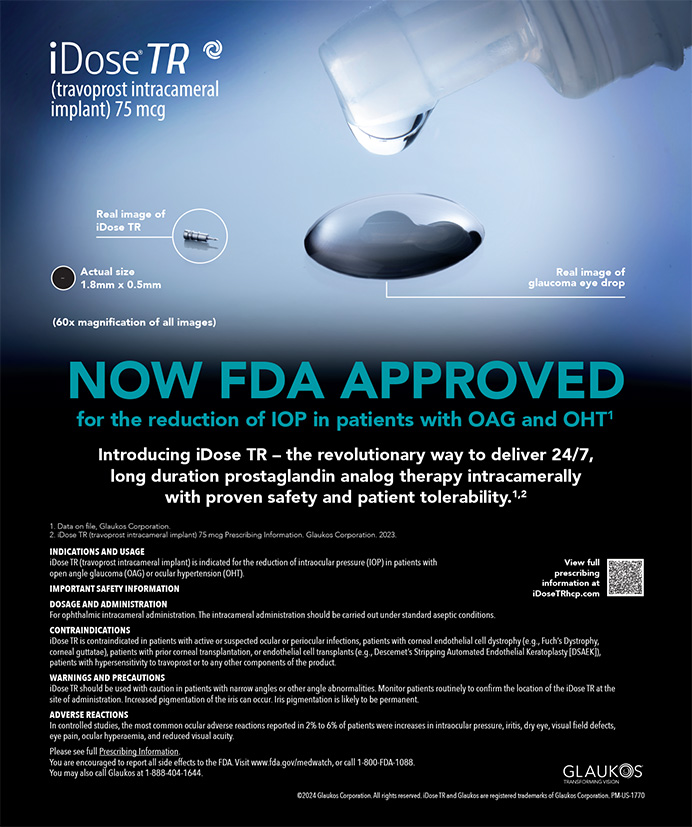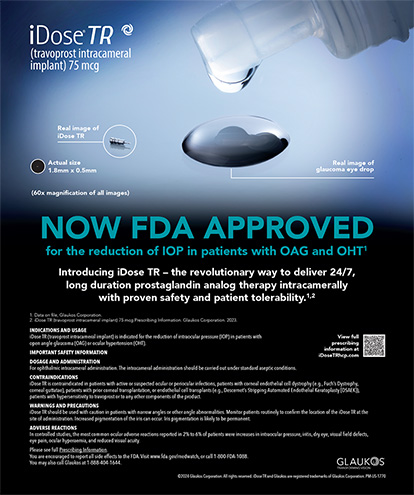I developed a technique called the “chip-and-flip” that depends on circumferentially dividing the nucleus, as opposed to sectorally dividing it. I divide the nucleus into a central endolenticular mass surrounded by an epinuclear shell. I sculpt and then sublux the residual central endonucleus (called the chip) by inserting a spatula underneath it, bringing it up into the plane of the pupil, and then phacoemulsifying it, after which I trim and flip the epinucleus. After Kunihiro Nagahara, MD, from Sakaide City, Japan, introduced phaco chop (which is perhaps the most elegant endolenticular phacoemulsification technique) in 1993, I began to use a bevel-down needle in conjunction with power modulations, a technique called “choo-choo chop and flip.” The procedure's name draws from the “choo-choo-choo-choo” sound that phacoemulsification produces in burst mode.
THE TECHNIQUE
The bevel-down technique that I prefer allows material to be mobilized within the endolenticular space, rather than traveling deep within the capsular bag and threatening the posterior capsule. The technique lifts the nuclear material to the level of the capsulorhexis and evacuates it with high vacuum.
I begin by making a 1-mm sideport incision to the left, and irrigating the anterior chamber with 0.5 mL preservative-free Xylocaine (AstraZeneca LP, Wilming-ton, DE). I then use the soft-shell technique designed by Steve Arshinoff, MD, of Toronto, Canada, to insert Viscoat (Alcon Laboratories, Fort Worth, TX) into the anterior chamber angle, distal to the sideport. Then, I apply Provisc (Alcon Laboratories) on top of the center of the lens capsule, underneath the Viscoat. After creating the clear corneal incision, I perform cortical cleaving hydrodissection in the two distal quadrants, followed by hydrodelineation. At this point, the surgeon should be able to easily rotate the nucleus within the capsular bag.
REMOVING THE NUCLEUS
Next, I insert the 30º microtip on the Legacy Phaco Emulsifier System (Alcon Laboratories) bevel-down to aspirate the epinucleus uncovered by the capsulorhexis. I use the Fine/Nagahara chopper (Rhein Medical, Tampa, FL) to stabilize the nucleus by lifting and pulling it slightly toward the incision. I then use the phaco tip with high vacuum and phaco power at two pulses per second to lollipop the nucleus before scoring and chopping it (Figure 1).
The Fine/Nagahara chopper is grooved on the horizontal arm near the vertical “chop” element, and the groove is parallel to the direction of the sharp edge of the vertical element. When scoring the nucleus, I always move the chopper in the direction that the sharp edge of the vertical element is facing. I bring it to the side of the phaco needle and chop the nucleus in half by pulling the chopper to the left and slightly down, while moving the phaco needle slightly up and to the right.
I then rotate the nuclear complex, reintroduce the chopper into the golden ring, lollipop the nucleus, and score and chop it again. The resulting pie-shaped segment remains embedded by the phaco tip. I then evacuate the segment using high vacuum and pulse mode phacoemulsification. I continue to rotate the nucleus in order to score, chop, and remove the remaining pie-shaped segments using high vacuum with intermittent bursts or pulses of phaco energy (Figure 2). After evacuating the first heminucleus, I rotate the second heminucleus to the distal portion of the bag, and use the chopper to stabilize it while I lollipop, score, and chop it. The surgeon may chop the pie-shaped segments a second time to minimize their size if necessary to evacuate easily.
EPINUCLEUS REMOVAL
After evacuating the endonuclear material, I use burst mode to trim the epinuclear rim in each of the four quadrants. As I trim each quadrant, the cortex in the adjacent capsular fornix flows over the bottom of the epinucleus, into the phaco tip (Figure 3). I push back the floor of the epinucleus to keep the bag stretched until I evacuate three of the quadrants of epinuclear rim and forniceal cortex. The surgeon must not allow the epinucleus to flip too early, to avoid a large amount of residual cortex remaining.
I then use the epinuclear rim of the fourth quadrant as a handle to flip the epinucleus. In most cases, the cortex evacuates with the remainder of the epinuclear floor and rim. I continue with the soft shell technique, filling the capsular bag with Provisc and injecting Viscoat into the center of the bag to help stabilize the movement of the foldable IOL as I implant it. Next, I evacuate any residual cortex and viscoelastic (the posterior capsule is now protected by the IOL).
CLOSING THOUGHTS
The choo-choo chop and flip technique enables surgeons to provide less invasive cataract surgery while maximizing rapid visual rehabilitation. It uses hydro forces to circumferentially divide and dismantle the nucleus, substituting ultrasound energy (in the form of grooving and cracking) for mechanical forces (in the form of chopping). This technique also employs high vacuum to remove nuclear material, rather than using ultrasound energy to convert nuclear material to an emulsate that is then aspirated. The technique maximizes safety, control, and efficiency in all cases, and permits surgeons to phacoemulsify harder nuclei in the presence of a compromised endothelium.


